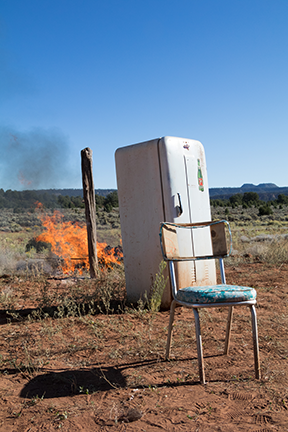-Temporary Exhibit-

Thirst-Quenchin’ (Navajo, NM), 2017 by Rapheal Begay
“Exploring the past, creating the present, and curating the future.”
The photography of Diné photographer Rapheal Begay presents an account of the Navajo Nation—without ever directly portraying any people—by focusing on the land and the material and visual culture of the people. By bringing these photographs into our museum and combining them with a small selection of related material culture from our collection, the Navajo Nation and New Mexico, the Maxwell Museum offers an opportunity to engage with a contemporary portrait of Diné people, picturing the land and culture viewed through the camera lens and words of Raphael Begay.
A Vernacular Response is the documentation of land and environment with respect to symbolism, perspective, and imagination reflective of the Diné way of life. An ongoing theme within the series is the acknowledgement and celebration of Indigenous innovation and future forward imaging. One can discern the role of creativity within Navajo art and life as a strategy for survival. The Navajo cultural teaching of hozho expresses the intellectual concept of order, the emotional state of happiness, the biological condition of health and well-being, and the aesthetic dimensions of balance, harmony, and beauty. Therefore, concept and content become synonymous with one another as both elements become interchangeable within the frame of the image.
“With the sky above and the earth below, I find myself connected to the land and to my surroundings. I believe the recollection of self through connection to memory creates a bridge between life and art. Through practicing the art of photography I am able to create my own path and, create community. At the end of the day, I strive to acknowledge and embrace each singular moment; A Vernacular Response.” Rapheal Begay
Many anthropology museums have their origins in the salvage anthropology and vanishing race theories of the late 19th and early 20th centuries, when anthropologists and museum curators collected the material culture of Indigenous Peoples thinking they would soon literally or culturally disappear, due to the impact of colonization. The Maxwell Museum, like so many other anthropology museums, contends with the legacy of such collecting practices, and works to facilitate more accurate contemporary portraits of those represented in its collections, with some notable portion of the collection being comprised of Diné (Navajo) material culture.